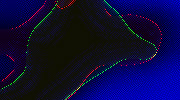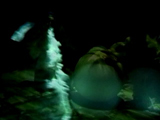
|
 |
||||||||||||||||||||||||
|
|||||||||||||||||||||||||
|
|
|||||||||||||||||||||||||
| contact sponge | Once the visitors have become comfortable in their "new bodies," they can then enter a central area, which is alive with other visitors, sound and image. In this space the visitors begin to discover how their gestures and physical movements begin to define the matter of the garden. For each new visitor who enters the garden, an initial period of experimentation and trial-error occurs in order to grasp what kinds of musical/sonic influence can be created in the room. Visitors move in time through a series of phenomenal relations-the metaphors invoked the room include writing, tracing, skrying and marking. In the first relation, as the players-visitors move inside the room, they experience a direct coupling with the room's media; the immediate results of their new gestures and movements. Visitors leave visual traces (particles) behind as well as "scratch" through the aural environment by way of distinct, multichannel sound which separates individual players' voices from the general room mix or cantus firmus. Tantamount to a rich player experience is the goal that each media system is designed with a high level of real time physical responsiveness and tangibility and media choreographic potential. The installation's visual and aural medias can be changed on the fly by the participants and are conducted through a real time, responsive dynamic system. Within the acoustic world of the installation, sound structures are being designed for maximum physical responsiveness. While at first, the visitors discover that floor movement is directly coupled to sound, they soon realize that physical bodily effort and movement is required to excite their individual sonic voices in the room mix. In this way, the TGarden demands a certain amount of effort, concentration and commitment from its players. It is a place that cannot be experienced in a few minutes, as it investigates players' sensibilities to active listening, viewing and playing with media simultaneously at several levels. In order to engage in a playful shaping of the space, the room's interaction and media complexity will increase through time. The players' bodies will slowly be 'injected' into the system, meaning that they will become less intruders and more master-players in the TGarden's game, able to shape the world through their gestures. Consequently, as the room evolves and as social relations begin to form as a result of visitor interaction, these locations and groupings also begin to effect both the local and global status of the room, varying melodic and rhythmic aspects of the media. This social context forms a central characteristic of the TGarden, with the room revealing itself in different ways to single players and groups of players. Memory, population density, bodily proximity affect growth and decay dynamics as well as the possibility of contamination and infection within the social space. Visitors leave traces and converse with each other in musical phrases as they move through the room. The traditional roles of spectator and actor dissolve into a field of media based from gesture and performance immanent in ordinary life where social play emerges without explicit rules or grammars. |
   |
|||||||||||||||||||||||
| TGarden intro production: 01 02 03 research credits support gallery | |||||||||||||||||||||||||
© sponge 1997 - 2002